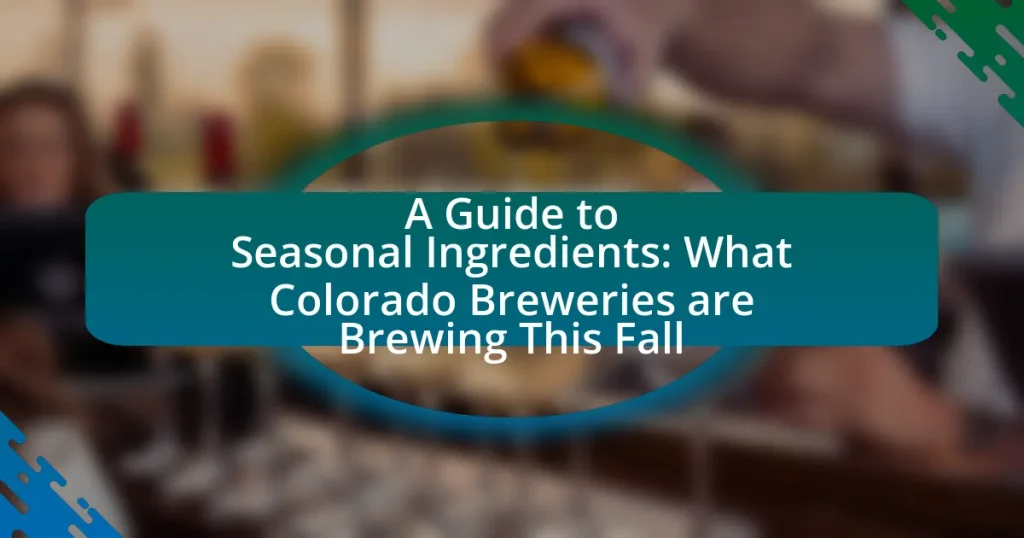The article focuses on seasonal ingredients in brewing, particularly highlighting the practices of Colorado breweries during the fall season. It explores how seasonal ingredients such as pumpkin, spices, and local produce enhance flavor profiles and create unique, limited-edition brews that resonate with consumers. The piece also discusses the importance of sourcing local ingredients, the trends emerging in fall brewing, and notable breweries known for their seasonal offerings. Additionally, it provides insights on how consumers can enjoy and pair these seasonal beers with fall foods, as well as tips for finding quality seasonal brews in their area.

What are Seasonal Ingredients in Brewing?
Seasonal ingredients in brewing refer to the specific fruits, spices, grains, and other components that are harvested or available during particular times of the year, influencing the flavor and character of the beer. For example, fall often sees the use of pumpkin, cinnamon, and nutmeg in brews, aligning with the harvest season and traditional flavors associated with autumn. This practice not only enhances the taste profile of the beer but also connects the brewing process to local agricultural cycles, promoting freshness and seasonal relevance in the craft beer industry.
Why are Seasonal Ingredients Important for Breweries?
Seasonal ingredients are important for breweries because they enhance flavor profiles and create unique, limited-edition brews that attract consumers. Utilizing ingredients that are in season allows breweries to capitalize on freshness, which can lead to more vibrant and complex flavors in their beers. For example, using fresh hops during the harvest season can significantly improve the aroma and taste of the final product. Additionally, seasonal ingredients often reflect local agricultural practices, fostering community connections and supporting local farmers. This practice not only promotes sustainability but also encourages innovation in brewing, as breweries experiment with different combinations and styles based on what is available at different times of the year.
How do Seasonal Ingredients Influence Flavor Profiles?
Seasonal ingredients significantly influence flavor profiles by introducing fresh, vibrant tastes that reflect the time of year. For example, fall ingredients like pumpkin, cinnamon, and apples add warmth and spice to brews, creating rich and comforting flavors that resonate with seasonal themes. Research indicates that the use of seasonal ingredients not only enhances the sensory experience but also aligns with consumer preferences for freshness and locality, as seen in the increasing popularity of craft beers that utilize locally sourced, seasonal produce. This connection between ingredient seasonality and flavor complexity is evident in the brewing practices of Colorado breweries, which often highlight these ingredients to create unique, limited-edition seasonal offerings.
What Role do Local Ingredients Play in Seasonal Brewing?
Local ingredients are essential in seasonal brewing as they enhance flavor profiles and promote regional identity. By utilizing ingredients sourced from nearby farms and producers, breweries can create unique seasonal beers that reflect the local terroir. For example, Colorado breweries often incorporate seasonal fruits like peaches and pumpkins, which not only provide distinct tastes but also support local agriculture. This practice fosters community relationships and sustainability, as it reduces transportation emissions and encourages the use of fresh, high-quality ingredients.
What Types of Seasonal Ingredients are Commonly Used in Fall Brewing?
Commonly used seasonal ingredients in fall brewing include pumpkin, spices like cinnamon and nutmeg, and various malts. Pumpkin is a traditional ingredient that adds flavor and color, while spices enhance the aromatic profile of the brew. Additionally, malts such as caramel and toffee contribute to the rich, warm flavors characteristic of fall beers. These ingredients are often featured in seasonal brews to reflect the flavors of autumn and are popular among breweries in Colorado and beyond.
Which Fruits and Vegetables are Popular in Fall Brews?
Pumpkin and apple are the most popular fruits and vegetables used in fall brews. Breweries often incorporate pumpkin for its rich flavor and seasonal appeal, while apple adds a crisp, refreshing note. The use of these ingredients aligns with consumer preferences during the fall season, as evidenced by the rise in pumpkin-flavored beers and ciders, which have become staples in many breweries’ seasonal offerings.
How do Spices Enhance Fall Beer Recipes?
Spices enhance fall beer recipes by adding depth, warmth, and complexity to the flavor profile. Ingredients such as cinnamon, nutmeg, and ginger evoke seasonal themes and complement malt-forward beers, creating a comforting experience. For example, cinnamon can impart a sweet and aromatic quality, while nutmeg adds a subtle earthiness. These spices not only enhance taste but also contribute to the overall aroma, making the beer more inviting. Breweries often utilize these spices to align their offerings with the fall season, appealing to consumer preferences for seasonal flavors.

What are Colorado Breweries Brewing This Fall?
Colorado breweries are brewing a variety of seasonal beers this fall, including pumpkin ales, Oktoberfest lagers, and spiced stouts. These styles often incorporate local ingredients such as Colorado-grown pumpkins and spices like cinnamon and nutmeg, reflecting the flavors of the season. For example, breweries like New Belgium and Odell Brewing are known for their fall releases that highlight these seasonal ingredients, contributing to the state’s rich craft beer culture.
Which Breweries are Notable for Their Fall Seasonal Offerings?
Notable breweries for their fall seasonal offerings include Odell Brewing Company, New Belgium Brewing, and Avery Brewing Company. Odell Brewing Company is recognized for its “Pumpkin Ale,” which features a blend of spices and pumpkin, capturing the essence of fall. New Belgium Brewing offers “Fat Tire Amber Ale,” which is popular during the autumn months for its balanced malt profile. Avery Brewing Company is known for its “Rumpkin,” a pumpkin ale aged in rum barrels, providing a unique twist on traditional fall flavors. These breweries consistently produce seasonal beers that reflect the flavors and ingredients associated with the fall season.
What Unique Brews are Each of These Breweries Creating?
Each brewery in Colorado is creating unique brews that highlight seasonal ingredients for fall. For example, New Belgium Brewing is crafting a Pumpkin Ale infused with locally sourced pumpkins and spices, while Odell Brewing is producing a Harvest Ale that features fresh hops from nearby farms. Additionally, Avery Brewing is offering a Maple Brown Ale that incorporates real maple syrup, showcasing the flavors of the season. These brews not only reflect the local agricultural bounty but also cater to the growing demand for seasonal craft beers.
How do These Breweries Source Their Seasonal Ingredients?
Breweries source their seasonal ingredients primarily through local partnerships with farmers and suppliers. By collaborating with regional agricultural producers, these breweries ensure the freshness and quality of ingredients like pumpkins, apples, and spices that are characteristic of fall brews. For instance, many Colorado breweries participate in community-supported agriculture (CSA) programs, allowing them to obtain seasonal produce directly from local farms, which not only supports the local economy but also enhances the flavor profile of their beers. This practice is evident in breweries that highlight specific farms on their labels, showcasing a commitment to sourcing ingredients that reflect the local terroir.
What Trends are Emerging in Fall Brewing in Colorado?
Emerging trends in fall brewing in Colorado include the increased use of seasonal ingredients such as pumpkin, spices, and malty flavors. Breweries are focusing on crafting beers that highlight the flavors of autumn, with many introducing pumpkin ales and spiced stouts that incorporate cinnamon, nutmeg, and clove. Additionally, there is a growing interest in barrel-aged beers, which offer complex flavors that resonate with the fall season. This trend is supported by the fact that breweries like Avery Brewing and Odell Brewing have reported a rise in the popularity of these styles during the fall months, reflecting consumer preferences for rich, warming beverages as temperatures drop.
How are Breweries Experimenting with Traditional Fall Flavors?
Breweries are experimenting with traditional fall flavors by incorporating ingredients such as pumpkin, cinnamon, and nutmeg into their seasonal brews. For instance, many Colorado breweries are crafting pumpkin ales that blend roasted pumpkin with spices to create a rich, autumnal taste. Additionally, some breweries are infusing their beers with locally sourced apples and pears, reflecting the harvest season. This experimentation not only enhances the flavor profile but also connects consumers to the seasonal ingredients available in their region, as evidenced by the growing popularity of these unique brews in fall beer festivals and local markets.
What Innovations are Being Introduced in Seasonal Brewing?
Innovations in seasonal brewing include the use of unique local ingredients, advanced fermentation techniques, and sustainable brewing practices. Colorado breweries are increasingly incorporating seasonal fruits, spices, and herbs to create distinct flavors that reflect the fall season. For example, breweries are experimenting with pumpkin, apple, and cinnamon in their brews, enhancing the seasonal experience. Additionally, some breweries are adopting innovative fermentation methods, such as barrel-aging and wild fermentation, to develop complex flavor profiles. Sustainable practices, like sourcing ingredients from local farms and reducing water usage, are also becoming more prevalent, aligning with consumer demand for environmentally friendly products. These innovations not only enhance the quality and variety of seasonal beers but also support local agriculture and sustainability efforts.

How Can Consumers Enjoy Seasonal Brews This Fall?
Consumers can enjoy seasonal brews this fall by exploring local breweries that offer unique, limited-edition beers crafted with autumn ingredients. Many Colorado breweries, for instance, incorporate flavors like pumpkin, cinnamon, and nutmeg into their fall brews, creating distinctive seasonal offerings. Engaging in brewery tours and tastings allows consumers to sample these seasonal creations directly from the source, enhancing their experience. Additionally, attending local beer festivals during the fall season provides opportunities to discover a variety of seasonal brews from multiple breweries in one location.
What Events or Festivals Celebrate Fall Seasonal Beers in Colorado?
Events and festivals that celebrate fall seasonal beers in Colorado include the Great American Beer Festival, held annually in Denver, which showcases a wide variety of seasonal brews from across the country, including many from Colorado breweries. Additionally, the Colorado Pumpkin Beer Festival in Longmont specifically highlights pumpkin ales and other fall-inspired beers, attracting numerous local breweries. The Fort Collins Beer Festival also features seasonal offerings, emphasizing the craft beer culture in the region. These events collectively provide a platform for breweries to present their fall seasonal beers, reflecting the state’s rich brewing tradition.
How Can Consumers Pair Seasonal Beers with Fall Foods?
Consumers can pair seasonal beers with fall foods by selecting brews that complement the flavors of autumn ingredients. For example, pumpkin ales enhance dishes featuring squash or roasted vegetables, while malty brown ales can balance the richness of hearty stews and meats. Additionally, spiced beers, such as those with cinnamon or nutmeg, pair well with desserts like apple pie or pecan tart. This pairing strategy is supported by the trend of breweries in Colorado crafting seasonal beers that highlight local harvests, making it easier for consumers to find suitable matches for their fall meals.
What Tips Should Consumers Consider When Exploring Seasonal Brews?
Consumers should consider the flavor profile, ingredient sourcing, and brewery reputation when exploring seasonal brews. Understanding the flavor profile helps consumers select brews that align with their taste preferences, as seasonal beers often feature unique ingredients like pumpkin, spices, or seasonal fruits. Additionally, sourcing ingredients locally can enhance freshness and support local economies, which is a common practice among Colorado breweries. Lastly, researching the brewery’s reputation for quality and innovation can guide consumers toward exceptional seasonal options, as breweries with a strong track record are more likely to produce noteworthy seasonal brews.
How Can Consumers Find the Best Seasonal Beers in Their Area?
Consumers can find the best seasonal beers in their area by utilizing local brewery websites, beer rating apps, and social media platforms. Local brewery websites often provide information on seasonal offerings and events, while beer rating apps like Untappd allow users to discover and review seasonal beers based on location. Additionally, social media platforms enable consumers to follow breweries and beer enthusiasts, gaining insights into popular seasonal selections and recommendations. This approach is effective as it leverages community knowledge and real-time updates on available seasonal brews.
What Should Consumers Look for in Quality Seasonal Brews?
Consumers should look for freshness, unique seasonal ingredients, and balanced flavors in quality seasonal brews. Freshness ensures that the beer captures the essence of the season, while unique ingredients like pumpkin, spices, or seasonal fruits enhance the flavor profile, making it distinct. Balanced flavors are crucial; a well-crafted seasonal brew should harmonize sweetness, bitterness, and aroma, creating a pleasant drinking experience. For example, many fall brews incorporate spices like cinnamon and nutmeg, which are characteristic of the season and contribute to a rich, inviting taste.


